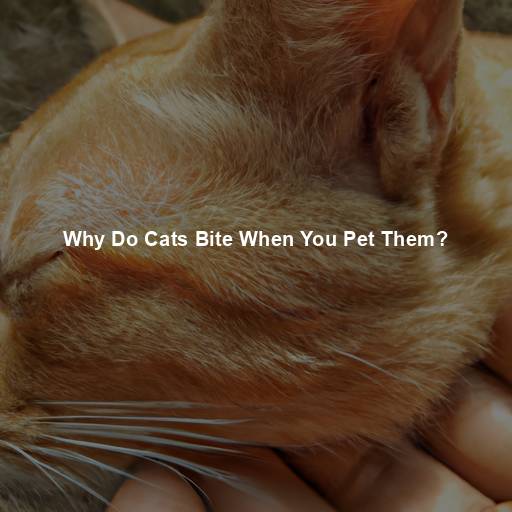Why Do Cats Bite When You Pet Them?
Last Updated on July 27, 2023 by Evan
Cats are known for their independent and mysterious nature, captivating us with their beauty and grace. But sometimes, our feline friends can exhibit behavior that leaves us puzzled and even a bit bewildered. One common question that often arises is, “Why do cats bite when you pet them”? In order to better understand this behavior, we need to delve into the fascinating world of feline psychology and explore the various reasons why our beloved cats may resort to biting when receiving affection.
Contents [hide]
The Nature of Cats: Independent and Territorial
Understanding the mysterious world of feline behavior unravels the enigma surrounding why our pet cats occasionally opt for a surprising nibble amidst a pleasant petting session. Beneath their fluffy exterior, lies an inherent and independent nature, setting them truly apart from their sociable canine counterparts. With an unwavering determination to protect their sacred territory, cats cautiously navigate their own solitary path, weaving a web of invisible boundaries. Thus, when it comes to receiving physical affection, these enigmatic felines possess particular desires and unique needs that demand our thoughtful consideration.
Sensory Overload: Too Much Stimulation
One possible reason why cats may bite during petting is due to sensory overload. Cats possess highly sensitive skin and a keen sense of touch. While some cats may enjoy being petted for extended periods, others may become overstimulated after a certain amount of physical contact. This overstimulation can trigger a defensive response, leading the cat to bite as a means of communication and boundary-setting.
When it comes to our feline friends, it’s crucial to decode their mysterious signals and behaviors in order to maintain a harmonious relationship. Keep a watchful eye on their ever-changing body language – the flattened ears, the twitching tail, the dilated pupils – all subtle yet significant hints that your cat may be inching closer to their limit. Remember, respecting their personal space and boundaries is key in averting unpleasant biting situations.
Another important aspect to consider is the phenomenon known as redirected aggression. Cats are highly sensitive creatures, and certain stimuli in their environment can trigger strong emotional responses. In some cases, a cat may be subjected to an external stimulus that causes them to feel threatened or anxious. However, instead of lashing out at the actual source of the stress, they redirect their aggression towards the closest target, which could be their well-meaning owner who happens to be petting them at the time.
Understanding and dealing with redirected aggression in cats can be a complex task, as its triggers often remain elusive and unpredictable. Whether it’s an external noise, the presence of another animal, or a mysterious scent, the catalyst behind a sudden biting incident may not always be obvious. Hence, when faced with such situations, it is essential to delve into the feline’s environment and investigate possible stressors that could be contributing to this perplexing behavior.
Understanding Cat Body Language: Keys to Avoiding Bites
Cats have a unique way of communicating their feelings and intentions through subtle body language cues. Learning to interpret these signals can help us foster a deeper understanding of our feline companions and minimize the risk of being bitten during petting sessions. Let’s explore some key elements of cat body language that can provide valuable insights into their state of mind.
Tail Position and Movement
Have you ever wondered what your feline friend is really feeling? Well, let me clue you in on a little secret – their tail speaks volumes! Yes, that’s right, those furry appendages can reveal a cat’s innermost emotions. When your cat’s tail stands tall and gracefully curved, you can rest assured that they’re feeling as calm as a cucumber.
Ear Position and Facial Expression
The position of a cat’s ears and the expression on their face can provide valuable clues about their emotional state. Ears that are held forward or slightly to the side typically indicate a relaxed and receptive attitude. On the other hand, flattened or backward-facing ears may suggest fear, discomfort, or agitation. Similarly, a relaxed facial expression with half-closed eyes indicates contentment, while wide-open eyes and a tense expression may signify anxiety or stress.
As avid cat lovers, we are constantly intrigued by the intricate world of feline behavior and communication. It never ceases to amaze us how their subtle visual cues can speak volumes about their emotional state. When we notice those adorable ears flattened or a slightly tense face, our instincts kick in to give them some alone time and allow them the opportunity to unwind and find their inner zen. Harnessing the power of observation, we can ensure our furry friends feel comfortable, appreciated, and ultimately lead happier lives.
Tips for Safe and Enjoyable Petting Sessions
Now that we have explored the possible reasons why cats may bite when being petted and gained insights into their unique communication cues, let’s delve into some practical tips for ensuring safe and enjoyable petting sessions with our feline companions.
Respect Your Cat’s Boundaries
Cats, oh cats, those enigmatic creatures of endless curiosity and captivating charm. Have you ever pondered the fascinating world of their tactile desires? Brace yourself, for in the realm of feline physical contact, preferences run wild like tangled whiskers. Each cat, a mysterious puzzle, spins its own web of unique needs and inclinations.
Start with Gentle Strokes
As we embark on the delightful journey of petting our feline companions, it behooves us to traverse this path with grace and finesse. Initiating a petting session requires a delicate touch, one that begins with gentle strokes upon the areas cats find most pleasing – the cheeks, chin, and the base of their ears. These delightful spots serve as gateways to a realm of euphoria, allowing our furry friends to embrace the experience at their own pace. It is crucial to remain vigilant, observing their reactions with every stroke, and gradually venturing into uncharted territories, ensuring their comfort is never compromised.
Avoid Sensitive Areas
When it comes to our feline friends, a delicate dance of petting is required. While a few cats may relish in the bliss of a belly rub, it’s important to approach this area with caution. You see, the belly is like a secret garden, vulnerable yet enticing. It’s best to divert your attention to other parts of their majestic bodies, like the soothing back or the enchanting sides of the neck.
Provide Interactive Play Sessions
When it comes to keeping our feline friends happy and balanced, a little petting just won’t cut it. It’s crucial to tap into their innate hunting instincts and give them an opportunity to release that energy in a playful way. Not only does interactive play help prevent any pent-up frustration or aggressive behavior, but it also adds a much-needed spark to their lives. So, the next time you engage with your cat, think beyond simple petting and grab those feather wands or puzzle toys to keep them on their toes, both mentally and physically.
Seek Professional Guidance
If your feline companion’s tendency to sink their teeth into everything in sight is causing you persistent agitation or genuine worry, it may be wise to tap into the expertise of a skilled veterinarian or a knowledgeable feline behaviorist. These trained professionals possess the know-how to carefully analyze your cat’s unique behavioral patterns and offer personalized recommendations to tackle the root causes behind their biting tendencies, thus fostering a safer and more harmonious environment for both you and your feline friend.
Playful Biting: Communication Through Play
In the world of feline frolics, playful biting reigns supreme, particularly among those tiny balls of fur known as kittens. As they frolic with their littermates and maternal figures, these adorable creatures imbibe crucial lessons in the arts of social interaction and hunting prowess. With each bite, they embark on a thrilling simulation of the age-old dance between predator and prey, honing their skills and sharpening their instincts. Through playful wrestling and nibbling sessions with their fellow furballs, these miniature adventurers not only master the delicate art of bite control but also embrace the essence of appropriate play.
As our beloved feline companions age gracefully, it’s not uncommon for them to surprise their humans with a perplexing display of gentle nibbles during those delightful cuddle sessions. Fear not, for this peculiar behavior is often a means of communication, revealing their sheer pleasure and extending an invitation for more interactive fun. However, it becomes paramount to establish some limits and divert their nibbles towards suitable playthings, preventing the reinforcement of this curious habit. So, let us navigate the labyrinth of playful feline antics and ensure harmonious interactions with our purring pals.
Overstimulation: Setting Boundaries
As fascinating as feline beings are, it’s important to acknowledge that their penchant for physical contact is as diverse as the colors of the rainbow. Some cats revel in an endless bout of petting, while others tread on the delicate line of overstimulation. This tipping point manifests itself in curious ways: a sudden switch in behavior, a restless dance of unease, or even a subtle shift in their enigmatic body language.
In the complex world of feline communication, biting can emerge as an enigmatic tool that cats employ to convey their desire for personal space and create boundaries. Understanding and deciphering these cryptic signals becomes pivotal in ensuring a harmonious coexistence. Savvy pet owners adeptly navigate this delicate dance by attentively observing their cats’ subtle cues and astutely acknowledging the halt in petting when discomfort manifests, thereby fostering an atmosphere of tranquility and safeguarding a secure interaction.
Fear and Anxiety: The Role of Trust
Cats, those enigmatic creatures, possess an inherent cautiousness, able to transform even the mildest of stimuli into a defensive reflex, like a biting beast. Hidden within their feline minds, somber memories of past traumas whisper, influencing their reactions to life’s intriguing encounters. But fear not, dear reader, for there is hope yet in the art of trust-building and the forging of a sanctuary, where our four-legged friends can find solace and shed the weight of their anxieties.
Does your feline friend turn into a biting ninja whenever you give them a loving pet? Don’t fret, because this peculiar behavior might actually be a clue to their hidden fears or anxieties. Fear not! With the help of gradual desensitization and counterconditioning techniques, you can turn petting into a joyful experience for your cat.
The Importance of Positive Reinforcement
Understanding why cats bite is essential in addressing this behavior. Rather than resorting to punishment or stern reprimands, it is important to adopt a positive and reward-based approach that fosters a sense of trust and security. By encouraging desirable behavior and redirecting their biting tendencies towards suitable toys or activities, we can help create a harmonious and safe environment for both the cat and its human companions. Let’s dive into the perplexing world of feline behavior and discover effective strategies to tackle this burst of biting energy!
Rewarding Gentle Behavior
We all love our furry feline friends, don’t we? But sometimes, they can be a little unpredictable during those cozy petting sessions. Fear not, for I bring you some paw-sitively purrfect advice to navigate the intricate world of cat behavior. When your whiskered companion behaves like a fluffy angel, shower them with praise, treats, or any other delightful rewards that will keep them coming back for more.
Providing Alternatives
Help your feline friend channel their energy and instincts in a more constructive way by offering alternative outlets for their biting tendencies. Engage them in interactive play sessions with stimulating toys or introduce scratching posts and puzzle toys to keep them mentally engaged. This not only curbs their biting incidents but also promotes their overall well-being, ensuring a harmonious and balanced lifestyle for your beloved cat.
Environmental Enrichment
Creating an enriched environment for your cat can also play a significant role in reducing biting behavior. Ensure they have access to stimulating toys, scratching surfaces, perches, and hiding spots. A well-enriched environment can help alleviate boredom, reduce stress, and provide opportunities for mental and physical exercise.
Seeking Professional Guidance
Concerned about your cat’s persistent biting behavior? Don’t fret! Seek assistance from trusted professionals like veterinary behaviorists or certified feline behavior consultants. They have the expertise to thoroughly analyze your furry friend’s behavior and offer customized strategies to tackle the root causes of the biting.
When it comes to our feline friends, it’s crucial to acknowledge their distinct personalities and idiosyncrasies. By approaching the issue of biting in a calm, compassionate manner and utilizing positive reinforcement techniques, you can nurture a stronger connection with your cat. It’s essential to be mindful of their limits, interpret their non-verbal cues, and establish a secure and stimulating living space to foster a happy and gratifying bond with your furry companion.
FAQs: Why do cats bite when you pet them?
Why do cats sometimes bite when you pet them?
Cat lovers, listen up! We all adore those purring fluff balls, but it’s essential to understand that they have their own quirks and personal space preferences. You know that feeling when someone keeps poking and prodding you, and you just want to scream, “Enough already!” Well, our feline friends can feel the same way. When cats reach their limit during a petting session, they might resort to nibbling or even biting to express their need for some alone time. We must respect their boundaries and tune in to their cues to avoid these prickly situations. Furthermore, it’s crucial to note that cats may bite when they are in discomfort or pain, seeking relief from our well-intentioned touches. So, let’s be mindful of their body language and sensitive areas, sparing them from unnecessary discomfort. Remember, a paw-sitive and harmonious relationship with our feline companions starts with understanding and respecting their unique needs.
How can I tell if my cat is becoming overstimulated?
It’s important to pay attention to your cat’s body language to determine if they’re becoming overstimulated. Some common signs to look out for include flicking or lashing tail, flattened or twitching ears, dilated pupils, sudden tensing of the body, or increased vocalization. These signs indicate that your cat might be reaching their threshold and may potentially bite if petting continues. To avoid this, it is essential to respect your cat’s boundaries and take breaks when necessary.
Are there any specific areas I should avoid petting to prevent biting?
As feline aficionados, we can all agree that cats have their own set of “no-go zones” when it comes to touch. Each cat is unique, and their sensitive spots can differ, but let’s talk about some common areas that might lead to unexpected nibbles. The belly, tail, paws, and hindquarters tend to be those delicate areas that can ruffle their fur and provoke a defensive response. However, there are always exceptions to the rule, so staying attuned to your cat’s cues is vital in deciphering their personal boundaries.
How can I prevent my cat from biting when I pet them?
To prevent your cat from biting when you pet them, it’s crucial to establish a positive and understanding relationship with your feline companion. Always approach your cat calmly and gently, taking care to read their body language for any signs of discomfort or overstimulation. Respect their boundaries and be mindful of the pressure and intensity of your petting. Experiment with different areas to identify where your cat enjoys being petted and where they prefer to avoid. Each cat is unique, so observing and understanding their preferences will help you avoid triggering a bite.
What should I do if my cat bites me while being petted?
If your cat bites you while being petted, it’s important not to scold or punish them as it can worsen the situation. Instead, calmly withdraw your hand and give your cat some space. Prevent any further attempts at petting and observe their behavior to ensure they are not in distress or feeling threatened. If the bites are frequent or intense, it may be beneficial to consult with a veterinarian or animal behaviorist to address any underlying issues causing the biting behavior and to find suitable solutions.







